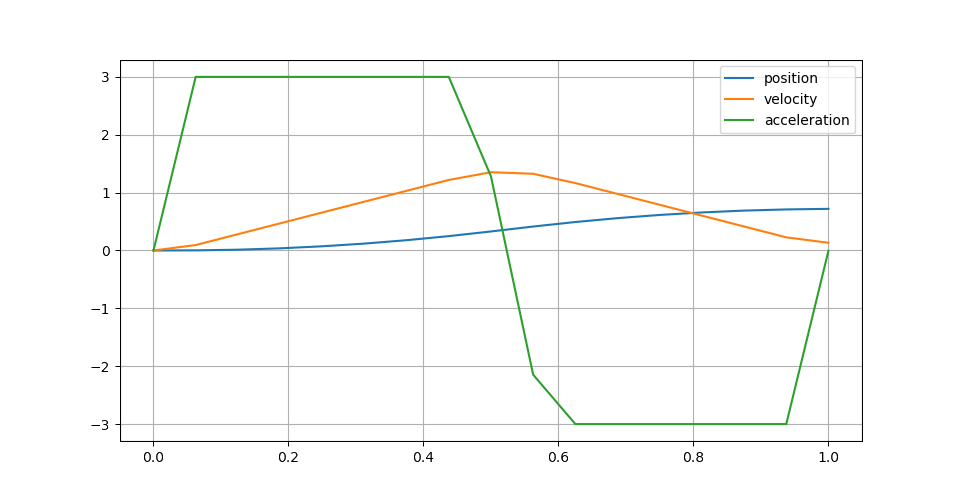Model predictive control (MPC) in Python for optimal-control problems that are quadratic programs (QP). This includes linear time-invariant (LTI) and time-variant (LTV) systems with linear constraints. The corresponding QP has the form:
This module is designed for prototyping. If you need performance, check out the alternatives below.
pip install qpmpcThis module defines a one-stop shop function:
solve_mpc(problem: MPCProblem, solver: str) -> PlanThe MPCProblem defines the model predictive control problem (LTV system, LTV constraints, initial state and cost function to optimize) while the returned Plan holds the state and input trajectories that result from optimizing the problem (if a solution exists). The solver string is used to select the backend quadratic programming solver.
Let us define a triple integrator:
import numpy as np
horizon_duration = 1.0 # [s]
N = 16 # number of discretization steps
T = horizon_duration / N
A = np.array([[1.0, T, T ** 2 / 2.0], [0.0, 1.0, T], [0.0, 0.0, 1.0]])
B = np.array([T ** 3 / 6.0, T ** 2 / 2.0, T]).reshape((3, 1))Suppose for the sake of example that acceleration is the main constraint acting on our system. We thus define an acceleration constraint |acceleration| <= max_accel:
max_accel = 3.0 # [m] / [s] / [s]
accel_from_state = np.array([0.0, 0.0, 1.0])
C = np.vstack([+accel_from_state, -accel_from_state])
e = np.array([+max_accel, +max_accel])This leads us to the following linear MPC problem:
from qpmpc import MPCProblem
x_init = np.array([0.0, 0.0, 0.0])
x_goal = np.array([1.0, 0.0, 0.0])
problem = MPCProblem(
transition_state_matrix=A,
transition_input_matrix=B,
ineq_state_matrix=C,
ineq_input_matrix=None,
ineq_vector=e,
initial_state=x_init,
goal_state=x_goal,
nb_timesteps=N,
terminal_cost_weight=1.0,
stage_state_cost_weight=None,
stage_input_cost_weight=1e-6,
)We can solve it with:
from qpmpc import solve_mpc
solution = solve_mpc(problem, solver="proxqp")The solution holds complete state and input trajectories as stacked vectors. For instance, we can plot positions, velocities and accelerations as follows:
import pylab
t = np.linspace(0.0, horizon_duration, N + 1)
X = solution.states
positions, velocities, accelerations = X[:, 0], X[:, 1], X[:, 2]
pylab.ion()
pylab.plot(t, positions)
pylab.plot(t, velocities)
pylab.plot(t, accelerations)
pylab.grid(True)
pylab.legend(("position", "velocity", "acceleration"))This example produces the following trajectory:
The behavior is a weighted compromise between reaching the goal state (weight 1.0) and keeping reasonable finite jerk inputs (weight 1e-6). The latter mitigate bang-bang accelerations but prevent fully reaching the goal within the horizon. See the examples folder for more examples.
This module is incomplete with regards to the following points:
- Cost functions: can be extended to general linear stage cost functions
- Documentation: there are some undocumented functions
- Test coverage: only one end-to-end test
Check out the contribution guidelines if you are interested in lending a hand.
This module is designed for faster prototyping rather than performance. You can also check out the following open-source libraries:
| Name | Systems | Languages | License |
|---|---|---|---|
| Copra (LTV fork) | Linear time-variant | Python/C++ | BSD-2-Clause |
| Copra (original) | Linear time-invariant | Python/C++ | BSD-2-Clause |
| Crocoddyl | Nonlinear | Python/C++ | BSD-3-Clause |
| mpc-interface | Linear time-variant | Python/C++ | BSD-2-Clause |
| pyMPC | Linear time-variant | Python | MIT |





